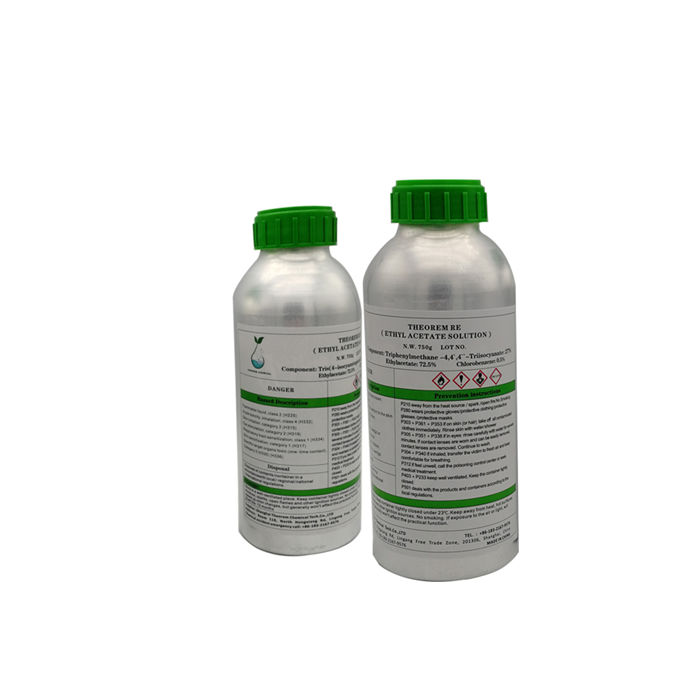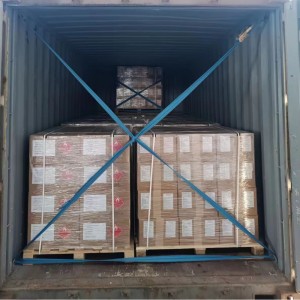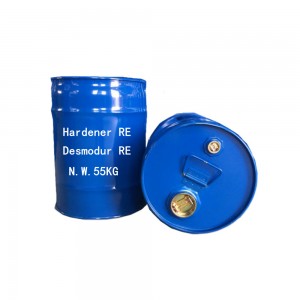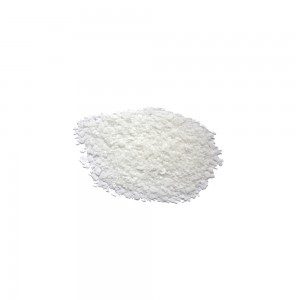China manufacturer good price Adhesive RFE / DESMODUR RFE CAS 4151-51-3 Tris(4-isocyanatophenyl) thiophosphate
High efficient adhesive RFE can alternate DESMODURE RFE
Chemical Name: Tris(4-isocyanatophenyl) thiophosphate
Trade Name: Adhesive RFE, Desmodur RFE
CAS No. 4151-51-3
Molecular formula: C21H12N3O6PS
Component:
Tris(4-isocyanatophenyl) thiophosphate / CAS No. 4151-51-3: 27%
Ethylacetate / CAS No. 141-78-6: 72.5%
Chlorobenzene / CAS No.: 0.5%
Our RFE, is an solventborne adhesive hardener of thiophosphoric-tris-(p-isocyanato-phenyl ester) in ethyl acetate, CAS number 4151-51-3. The light-color is an universal curing agent / crosslinker (isocyanate-type) majorly applied on adhesives for natural and/or synthetic rubber, especially for rubber materials. Benefits with its light-color to colorless and yellowing resistance, RFE is an ideal solution for strict demanding for color, well-suited for grafted cr adhesive, chloroprene rubber adhesive and hydroxyl polyurethane adhesive. RFE can also improve the bonding of plasticizer PVC, oily SBR, top layer/primer leather, silk and etc. RFE can also be added in oil skin treatment agent to get better adhesion reinforcing and oil resistance. The solvent of RFE is ethyl acetate (EAC), which is in line with the regulation of environment protection in comparison to methylene chloride. Adding RFE into adhesives, it causes the crosslinking reaction and connect substrates, especially for rubber materials.
Two-component adhesive must be used within the applicable period after putting after putting in RFE. The length of applicable period is not only related to the polymer content of adhesive, but also other relevant components ( Like reisn, antioxygen, plasticizer, solvent, etc. When close to the applicable period, usually a few hours or one working day, adhesive becomes more difficult to operate, and viscosity rises soon, Finally, it becomes the irreversible jelly.
The RFE can be used as an adhesive for rubber and metal, and as a crosslinking curing agent for rubber solution adhesives and solvent-based polyurethane adhesives.
The amount is generally 4% to 7% of the above-mentioned solvent-based adhesives. It is especially used for bonding colorless or light-colored products.
Application including:
- Bonding for vulcanized (or unvulcanized) rubber and PVC, PU, SBS and other polymers bonding of materials and metals (iron/aluminum).
- As a curing agent for neoprene adhesives to improve the bonding strength; curing agent for rubber and fabric bonding.
- As a cross-linking agent for the hydroxyl components of polyurethane products (elastomers, coatings, etc.).
- As a cross-linking agent for hydroxyl-terminated polyurethane adhesives used in the shoe industry, which can improve the initial adhesion strength, heat resistance and other indicators.
- Mostly applied on footwear, suitcase, bags industries to bond the fabric with PVC and/or PU.
Recommend dosage:
Depending on the bonding process and substrates, the most suitable dosage is recommended for a wide range of options.
For curing adhesive of 100 parts by weight (p.b.w.) based on:
Graft-Chloroprene rubber (rubber content approx. 16%): 3%-5% p.b.w. RFE
Chloroprene rubber (rubber content approx. 20%): 5%-7% p.b.w. RFE
Hydroxyl polyurethane (polyurethane content approx. 15%): 3%-5% p.b.w. RFE
Compatibility with solvents:
Our RFE can be diluted with anhydrous and alcohol-free ethyl acetate dichloropropane, trichloroethylene, acetone, methyl ethyl ketone, toluene and other solvents. Adding relatively large proportions of aliphatic hydrocarbons can result in turbidity. However, the solution of aliphatic hydrocarbons in natural rubber(NR) shows good compatibility with RFE. Thus, there is no need to add other solvents.
Packing:
Type 1. 750g/bottle, 20 bottles in one carton, 24 or 30 cartons in one pallet;
Type 2. 20kg/drum, 18 drums or 27 drums in one pallet;
Type 3. 55kg/drum, 8 or 12 drums in one pallet;
Type 4. 180kg/drum, 4 drums in one pallet
Storage:
Please stored in the original sealed jar 5℃-32℃, the products can be preserved stable for 12 moths.
All our series products are very sensitive to the moisture; It will produce carbon dioxide and insoluble urea in the reaction with water. If exposure to the air or/and light, it will speed up color changes of products.
(But the practical function will bot be affected.)
Safety:
Dangerous nature, highly inflammable, stimulate to eyes, if inhaled can cause allergies. Frequent touch may result in skin dry out or craze. Steam of products can make the person fatigue and vertigo.
United Nations number: 1173
United Nations Transport Name: FLAMMABLE LIQUID, N.O.S. (Ethyl Acetate, Monochlorobenzene)
Transport risk level: 3
Packaging category: II
Environmental hazard: no
HS CODE: 2929109000
|
ITEM
|
INDEX
|
|
Assay of NCO
|
7.2±0.2%
|
|
Solid content
|
27±1%
|
|
Viscosity ( 20℃)
|
3 mPa.s
|
|
Solvent
|
Ethyl acetate
|
|
Appearance:Transpareant light yellow liquid. Its color does not affect the boding strength.
|
|
|
* In addition:The company could research and develop the new products according to the special demand of our clients.
|
|
|
1. |
|
|
2. |
|
|
3. |
|
|
4. |
|
|
5. |
|
|
6. |
|
|
7. |
|
|
8. |
|
| 9. | NDI(1,5-Naphthalene Diisocyanate) CAS 3173-72-6 |
| 10. | PPDI (1,4-Phenylene Diisocvanate) |
| 11. | TODI CAS 91-97-4 |
| 12. | Dimeryl Diisocyanate DDI CAS NO. 68239-06-5 |
| 13. | MOCA CAS 101-14-4 |
| 14. | PTSI CAS 4083-64-1 |
| 15. | etc... |















